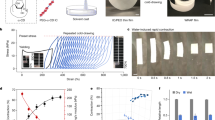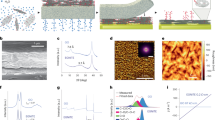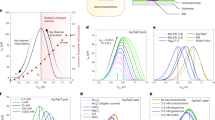Abstract
Bioelectronic devices that are tetherless and soft are promising developments in medicine, robotics and chemical computing. Here, we describe bioinspired synthetic neurons, composed entirely of soft, flexible biomaterials, capable of rapid electrochemical signal transmission over centimetre distances. Like natural cells, our synthetic neurons release neurotransmitters from their terminals, which initiate downstream reactions. The components of the neurons are nanolitre aqueous droplets and hydrogel fibres, connected through lipid bilayers. Transmission is powered at these interfaces by light-driven proton pumps and mediated by ion-conducting protein pores. By bundling multiple neurons into a synthetic nerve, we have shown that distinct signals can propagate simultaneously along parallel axons, thereby transmitting spatiotemporal information. Synthetic nerves might play roles in next-generation implants, soft machines and computing devices.

This is a preview of subscription content, access via your institution
Access options
Access Nature and 54 other Nature Portfolio journals
Get Nature+, our best-value online-access subscription
$29.99 / 30 days
cancel any time
Subscribe to this journal
Receive 12 print issues and online access
$259.00 per year
only $21.58 per issue
Buy this article
- Purchase on Springer Link
- Instant access to full article PDF
Prices may be subject to local taxes which are calculated during checkout




Similar content being viewed by others
Data availability
Data supporting the findings of this study are available within the paper and its Supplementary Information. Additional source data and design files that support these findings are available in the Figshare repository https://doi.org/10.6084/m9.figshare.17122127.v1. Alternatively, data are also available from the corresponding author upon reasonable request.
References
Someya, T., Bao, Z. & Malliaras, G. The rise of plastic bioelectronics. Nature 540, 379–385 (2016).
Choi, S. et al. Highly conductive, stretchable and biocompatible Ag–Au core–sheath nanowire composite for wearable and implantable bioelectronics. Nat. Nanotechnol. 13, 1048–1056 (2018).
Lacour, S., Courtine, G. & Guck, J. Materials and technologies for soft implantable neuroprostheses. Nat. Rev. Mater. 1, 16063 (2016).
Yang, X. et al. Bioinspired neuron-like electronics. Nat. Mater. 18, 510–517 (2019).
Kim, Y. et al. A bioinspired flexible organic artificial afferent nerve. Science 360, 998–1003 (2018).
Wehner, M. et al. An integrated design and fabrication strategy for entirely soft, autonomous robots. Nature 536, 451–455 (2016).
Karbalaei Akbari, M. & Zhuiykov, S. A bioinspired optoelectronically engineered artificial neurorobotics device with sensorimotor functionalities. Nat. Commun. 10, 3873 (2019).
Kuhnert, L., Agladze, K. I. & Krinsky, V. I. Image processing using light-sensitive chemical waves. Nature 337, 244–247 (1989).
Gizynski, K. & Gorecki, J. Chemical memory with states coded in light controlled oscillations of interacting Belousov–Zhabotinsky droplets. Phys. Chem. Chem. Phys. 19, 6519–6531 (2017).
Parrilla-Gutierrez, J. M. et al. A programmable chemical computer with memory and pattern recognition. Nat. Commun. 11, 1442 (2020).
Keene, S. T. et al. A biohybrid synapse with neurotransmitter-mediated plasticity. Nat. Mater. 19, 969–973 (2020).
Van de Burgt, Y. et al. Organic electronics for neuromorphic computing. Nat. Electron. 1, 386–397 (2018).
Misra, N. et al. Bioelectronic silicon nanowire devices using functional membrane proteins. Proc. Natl Acad. Sci. USA 106, 13780–13784 (2009).
Amit, M. et al. Measuring proton currents of bioinspired materials with metallic contacts. ACS Appl. Mater. Interfaces 10, 1933–1938 (2018).
Lodish, H. et. al. Molecular Cell Biology 8th edn (W.H. Freeman, 2016).
Pereda, A. Electrical synapses and their functional interactions with chemical synapses. Nat. Rev. Neurosci. 15, 250–263 (2014).
Liu, Y. et al. Soft and elastic hydrogel-based microelectronics for localized low-voltage neuromodulation. Nat. Biomed. Eng. 3, 58–68 (2019).
Keplinger, C. et al. Stretchable, transparent, ionic conductors. Science 341, 984–987 (2013).
Yang, C. & Suo, Z. Hydrogel ionotronics. Nat Rev Mater 3, 125–142 (2018).
Owens, R. M. & Malliaras, G. G. Organic electronics at the interface with biology. MRS Bull. 35, 449–456 (2010).
Strakosas, X., Bongo, M. & Owens, R. M. The organic electrochemical transistor for biological applications. J. Appl. Polym. Sci. 132, 41735 (2015).
Selberg, J., Gomez, M. & Rolandi, M. The potential for convergence between synthetic biology and bioelectronics. Cell Systems 7, 231–244 (2018).
Kim, C. Y. et al. Soft subdermal implant capable of wireless battery charging and programmable controls for applications in optogenetics. Nat. Commun. 12, 535 (2021).
Villar, G., Graham, A. D. & Bayley, H. A tissue-like printed material. Science 340, 48–52 (2013).
Booth, M. J. et al. Light-activated communication in synthetic tissues. Sci. Adv. 2, e1600056 (2016).
Holden, M. A., Needham, D. & Bayley, H. Functional bionetworks from nanoliter water droplets. J. Am. Chem. Soc. 129, 8650–8655 (2007).
Restrepo Schild, V. et al. Light-patterned current generation in a droplet bilayer array. Sci. Rep. 7, 46585 (2017).
Jones, G. et al. Autonomous droplet architectures. Artif. Life 21, 195–204 (2015).
Dupin, A. & Simmel, F. C. Signalling and differentiation in emulsion-based multi-compartmentalized in vitro gene circuits. Nat. Chem. 11, 32–39 (2019).
Chow, B. Y. et al. High-performance genetically targetable optical neural silencing by light-driven proton pumps. Nature 463, 98–102 (2010).
Yanoff, M. & Sassani, J. W. Ocular Pathology 8th edn 494 (Elsevier, 2020).
Bada Juarez, J. F. et al. Structures of the archaerhodopsin-3 transporter reveal that disordering of internal water networks underpins receptor sensitization. Nat. Commun. 12, 629 (2021).
Ernst, O. P. et al. Microbial and animal rhodopsins: structures, functions and molecular mechanisms. Chem. Rev. 8, 126–163 (2014).
Bamberg, E. et al. Photocurrents generated by bacteriorhodopsin on planar bilayer membranes. Eur. Biophys. J. 5, 277–292 (1979).
Inoue, K. et al. Converting a light-driven proton pump into a light-gated proton channel. J. Am. Chem. Soc. 137, 3291–3299 (2015).
Huang, K.-S., Bayley, H. & Khorana, H. G. Delipidation of bacteriorhodopsin and reconstitution with exogenous phospholipid. Proc. Natl Acad. Sci. USA 77, 323–327 (1980).
Ming, M. et al. pH dependence of light-driven proton pumping by an archaerhodopsin from Tibet: comparison with bacteriorhodopsin. Biophys. J. 90, 3322–3332 (2006).
Bean, B. The action potential in mammalian central neurons. Nat. Rev. Neurosci. 8, 451–465 (2007).
Burnstock, G. Historical review: ATP as a neurotransmitter. Trends Pharmacol. Sci. 27, 166–176 (2006).
Soto, E., Ortega-Ramírez, A. & Vega, R. Protons as messengers of intercellular communication in the nervous system. Front. Cell. Neurosci. 12, 342 (2018).
Du, J., Hossain, Z. & Mandal, J. Protons: a neurotransmitter in the brain. Edorium J. Cell Biol. 3, 1–3 (2017).
Guerra-Gomes, S., Sousa, N., Pinto, L. & Oliveira, J. F. Functional roles of astrocyte calcium elevations: from synapses to behaviour. Front. Cell. Neurosci. 11, 427 (2018).
Tunuguntla, R. et al. Lipid bilayer composition can influence the orientation of proteorhodopsin in artificial membranes. Biophys. J. 105, 1388–1396 (2013).
Yoshimura, K. & Kouyama, T. Structural role of bacterioruberin in the trimeric structure of archearhodopsin-2. J. Mol. Biol. 375, 1267–1281 (2008).
Graham, A. D. et al. High-resolution patterned cellular constructs by droplet-based 3D printing. Sci. Rep. 7, 7004 (2017).
Alcinesio, A., Krishna Kumar, R. & Bayley, H. Functional multivesicular structures with controlled architecture from 3D-printed droplet networks. ChemSystemsChem 4, e202100036 (2021).
Jeong, D.-W. et al. Enhanced stability of freestanding lipid bilayer and its stability criteria. Sci. Rep. 6, 38158 (2016).
Preibisch, S., Saalfeld, S. & Tomancak, P. Globally optimal stitching of tiled 3D microscopic image acquisitions. Bioinformatics 25, 1463–1465 (2009).
Acknowledgements
Work in the H.B. group (including C.E.G.H. and V.R.S.) is supported by a European Research Council Advanced Grant (SYNTISU). C.E.G.H. was also supported by Oxford’s Doctoral Training Centre for Synthetic Biology, which is funded by the Engineering and Physical Sciences Research Council and the Biotechnology and Biological Sciences Research Council (EP/L016494/1). Microbial rhodopsins were prepared by J.V. and a gift from the A. Watts Group (Department of Biochemistry, University of Oxford, funded by DSTL UK (DSTLX-1000099768)) and αHL the gift of I. Cazimoglu (Bayley Group, University of Oxford). We thank D. Lunn for discussions regarding the use of elastomer. We also thank A. Walter and Y. Tanaka (Tecella) for their assistance.
Author information
Authors and Affiliations
Contributions
C.E.G.H., V.R.S., and H.B. conceived the ideas behind the project, discussed the data and wrote the manuscript. C.E.G.H. (with assistance from V.R.S.) carried out the experiments and analysed the data. J.V. prepared the microbial rhodopsins.
Corresponding author
Ethics declarations
Competing interests
The authors declare no competing interests.
Peer review
Peer review information
Nature Chemistry thanks the anonymous reviewers for their contribution to the peer review of this work.
Additional information
Publisher’s note Springer Nature remains neutral with regard to jurisdictional claims in published maps and institutional affiliations.
Supplementary information
Supplementary Information
Supplementary Figs. 1–31, Materials and Methods, theoretical considerations and references.
Rights and permissions
About this article
Cite this article
Hoskin, C.E.G., Schild, V.R., Vinals, J. et al. Parallel transmission in a synthetic nerve. Nat. Chem. 14, 650–657 (2022). https://doi.org/10.1038/s41557-022-00916-1
Received:
Accepted:
Published:
Issue Date:
DOI: https://doi.org/10.1038/s41557-022-00916-1
This article is cited by
-
Hydrogels as functional components in artificial cell systems
Nature Reviews Chemistry (2022)



